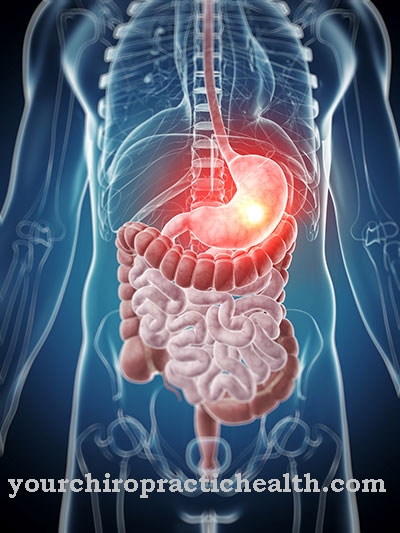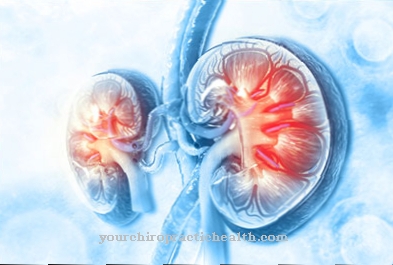The Alveolitis sicca occurs as a complication after tooth extraction. The alveolus becomes inflamed. The alveolus is the bony tooth socket.
What is alveolitis sicca?

In alveolitis sicca, the bony tooth socket becomes inflamed after tooth extraction. The disease occurs two to four days after tooth extraction and is accompanied by severe pain. The complication occurs mainly in the area of the lower jaw and predominantly in the angle of the jaw. The bone here is very compact and has little blood supply. Inflammation can develop more quickly.
The alveolitis sicca is also called Dolor post extractionem designated. This name reflects the main symptom of the disease. Dolor post extractionem in translation means pain after extraction. In medical parlance, the term is also used more and more frequently Post-extraction syndrome. Another titling is Alveolar ostitis.
causes
Each tooth is attached to the bone in the alveolus with fibers. After removing the tooth, a bony and free space is created here. This fills with blood. The resulting blood clot is also known as a coagulum. It closes the open wound and protects the tooth socket from bacteria and other pathogens. Basically, the coagulum acts as a kind of natural bandage.
After small blood vessels have grown in, the coagulum is converted into connective tissue. The cause of alveolitis sicca is a disintegration of the blood clot. The blood clot can be removed from the alveolus by rinsing the mouth too vigorously. However, bacteria may also have got into the wound and removed the blood clot. Some patients also tear the coagulum out of the wound with the swab.
After particularly difficult tooth extractions, often only an unstable coagulum forms. Even if there is very little bleeding from the wound, no coagulum can form. Another cause is incomplete removal of the tooth or the leaving behind infected tissue. As a result, the bone in the alveolus is exposed unprotected. The surrounding tissue is also inflamed.
You can find your medication here
➔ Toothache medicationSymptoms, ailments & signs
The exposed bone of the alveolus causes severe pain. The pain radiates to the entire jaw area. Bad breath can also occur due to the inflammation. Normally, however, there is neither abscess formation nor suppuration. The pain is the only recognizable sign of inflammation.
However, it can be so severe that patients cannot sleep at night and feel very sick and exhausted from the pain. The over-the-counter pain relievers bring little to no improvement. The pain can last for several weeks if left untreated.
Diagnosis & course
If you have severe toothache after a tooth extraction, you should see a dentist as soon as possible. Upon inspection of the oral cavity, it will find a bloodless alveolus. The blood clot is no longer visible. The differential diagnostic differentiation is difficult. It is possible that the patients are just particularly sorry and that it is not at all an alveolitis sicca.
However, the pain can also hide an inflammation of the bone marrow, a so-called osteomyelitis. On the one hand, this rarely occurs after tooth extractions; on the other hand, this inflammation usually shows up as a multiple abscess. Unintentional opening of the maxillary sinus by the doctor must also be considered. This creates a so-called mouth-antrum connection.
In order to rule out such an opening of the maxillary sinus after the extraction, a nose-blowing test is carried out. The patient should snort into his nose with his nose closed. The mouth stays open. Due to the pressure build-up in the nasal cavity, the pressure in the throat smoke increases under physiological conditions. The ears "crack". The soft palate seals the oral cavity so that no pressure builds up in the oral cavity.
When the maxillary sinus is opened, the air flows at high pressure into the maxillary sinus and from there into the mouth via the mouth-antrum connection. A loud hissing or whistling sound is emitted from the alveolus. In this case, the nose blow attempt is positive and a tight seal must be made in order to close the connection.
Usually, however, the pain caused by opening the jaw is not as severe. If in doubt, the attempt can still be made at this stage.
Complications
Alveolitis sicca is a postoperative complication that occurs a few days after tooth extraction. If the symptom occurs, the person affected should see their dentist immediately. Once a tooth has been removed, a blood clot forms in the empty tooth socket.
The clot prevents the penetration of germs that cause infections and helps wound healing. However, as soon as the blood clot is lost or dissolves, the bone is exposed and the pathogens penetrate deep into the jaw. The open wound is very painful and inflamed. Sometimes there is an unpleasant putrid smell.
For most people, alveolitis sicca develops in the lower jaw, especially when the wisdom teeth are removed. Other complications include: a jaw clamp, headache, tissue loss, and fever. If the wound appears relatively stable, caution is still required. The blood clot can be damaged and lost if you brush too hard.
If there is reduced bleeding during tooth extraction, no blood clot is formed and the area quickly becomes inflamed, a dry alveolus results. This must be carefully treated under local anesthesia and the necrotic tissue removed. The dentist can provide relief through appropriate measures and medication. Nicotine should be avoided until the healing process is complete, as this substance negatively affects wound healing.
When should you go to the doctor?
With alveolitis sicca, discomfort occurs to the teeth. The sick suffer from very severe pain that affects the exposed bones. It is not uncommon for this pain to spread to other regions of the body, so that severe pain also occurs in the head or ears. The quality of life of the patient is significantly reduced and there is usually severe exhaustion.
For this reason, the person affected should always consult a doctor immediately if there is severe pain in the teeth that does not go away on its own in a short period of time. Furthermore, the pain usually also reduces the intake of food and fluids, so that underweight or deficiency symptoms can occur.
Dehydration of the patient can also occur due to alveolitis sicca. Furthermore, those affected suffer from bad breath and severe inflammation. The pain can lead to sleep problems at night. As a rule, they cannot be restricted with the help of pain relievers. A visit to the doctor is also useful for these complaints.
Doctors & therapists in your area
Treatment & Therapy
Alveolitis sicca is treated surgically. Necroses are removed under local anesthesia, thus creating fresh wound surfaces. The remnants of the disintegrated coagulum are cleared out and the alveolus is scraped out. This painful process is performed with a sharp spoon and is known as excochleation.
A tamponade is then inserted. This is soaked with pain reliever and disinfectant drugs and must be changed at regular intervals by the treating dentist until it is completely healed. This is the only way to prevent further infection of the alveolus. Alternatively, the dentist can inject an absorbable paste into the alveolus using a thin cannula.
In milder cases, careful cleaning and rinsing of the wound area is sufficient. No local anesthesia is required. Even inflammations that have already subsided are no longer removed. Normal wound healing has already started here. Treatment would delay healing.
Wound healing after alveolitis sicca can take several weeks. During this time, the bone overgrows with mucous membrane and is therefore significantly less sensitive to irritation. The acute symptoms subside after a few days with drug treatment.
Outlook & forecast
As a rule, alveolitis sicca causes severe discomfort and inflammation in the oral cavity. Those affected primarily suffer from very severe pain. This pain can also spread to other areas of the body. It is not uncommon for people to rest pain, so that those affected can suffer from sleep problems. Furthermore, the intake of liquid and food is restricted, so that underweight or other deficiency symptoms can occur.
The quality of life of the person affected is significantly restricted and reduced by alveolitis sicca. The disease also manifests itself as a strong and unpleasant halitosis, which has a negative effect on social contacts and can lead to psychological complaints. There is also a general feeling of illness and fatigue. Often times, the pain of alveolitis sicca cannot be relieved by ordinary pain relievers.
The treatment of alveolitis sicca is carried out by surgery. This usually has to be repeated a few times until the inflammation has completely healed. Usually there is no further discomfort or pain afterwards.
You can find your medication here
➔ Toothache medicationprevention
The administration of antibiotics and local rinsing with chlorhexidine have proven to be effective preventive measures. Prophylactic treatment with diclofenac, ibuprofen or antifibrinolytics, however, is not effective.
Aftercare
In most cases of alveolitis sicca, direct follow-up care is not possible or necessary. People primarily need medical treatment to stop the inflammation and prevent further complications. If the alveolitis sicca is recognized and treated early, there will be no further compilations and, as a rule, a complete healing of this complaint.
Alveolitis sicca is treated directly by a dentist and is usually without complications. Furthermore, after the procedure, the patient is dependent on taking painkillers and antibiotics to avoid further inflammation. It is important to ensure that the medication is taken regularly and that there are potential interactions with other medications.
Those affected should not drink alcohol while taking antibiotics, as this can weaken the effect. The disease continues to develop positively. In order to avoid the recurrence of alveolitis sicca, those affected should take care of their teeth and follow the usual hygiene measures. The life expectancy of the patient is not negatively influenced by alveolitis sicca.
You can do that yourself
In the event of complaints after the removal of a tooth, a dentist must be consulted. Under no circumstances should those affected try to treat alveolitis sicca alone.
The patients can, however, help to have a positive influence on the course of the disease or, ideally, to prevent it immediately. The most common reason for tooth loss is tooth decay, which is caused by poor oral hygiene. Those who suffer from tooth decay should brush their teeth after every meal whenever possible. It is especially important to clean your teeth after eating sticky sweets.
This also includes healthy foods such as bananas. Disposable toothbrushes from pharmacies or medical retailers facilitate dental care outside the home. Highly acidic foods and luxury foods such as sour fruit, fruit juices or acidic soft drinks, as well as desserts, should be avoided.
After a tooth extraction, it is important to ensure that the blood clot (the blood clot that closes the wound) is not damaged or destroyed by the toothbrush during daily dental care. The consumption of alcoholic beverages can also impair wound healing. Those affected should strictly follow the relevant instructions of the treating dentist.
If an inflammation does occur, regular mouthwashes with antiseptics, which are available over the counter at the pharmacy, help. Many patients also respond positively to douching with sage tea.

.jpg)

.jpg)























